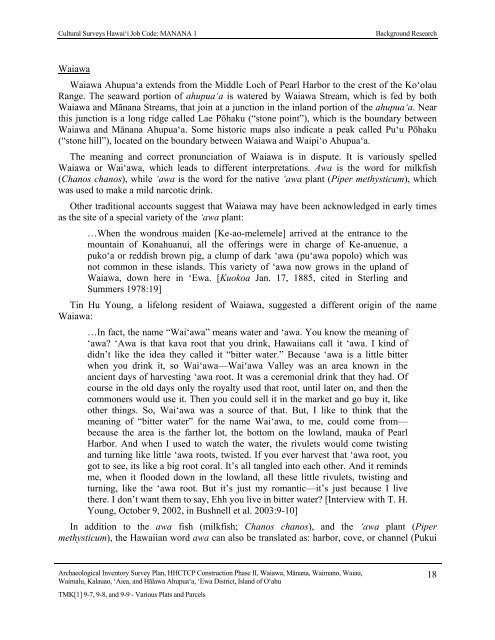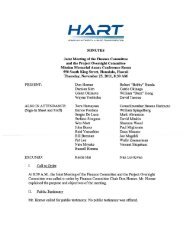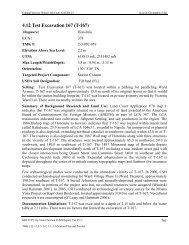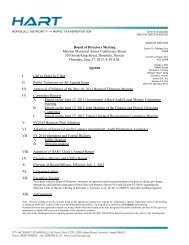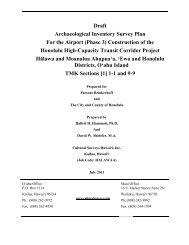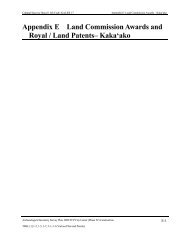AISP Kamehameha Highway Guideway - Honolulu Rail Transit Project
AISP Kamehameha Highway Guideway - Honolulu Rail Transit Project
AISP Kamehameha Highway Guideway - Honolulu Rail Transit Project
Create successful ePaper yourself
Turn your PDF publications into a flip-book with our unique Google optimized e-Paper software.
Cultural Surveys Hawai‘i Job Code: MANANA 1<br />
Background Research<br />
Waiawa<br />
Waiawa Ahupua‘a extends from the Middle Loch of Pearl Harbor to the crest of the Ko‘olau<br />
Range. The seaward portion of ahupua‘a is watered by Waiawa Stream, which is fed by both<br />
Waiawa and Mānana Streams, that join at a junction in the inland portion of the ahupua‘a. Near<br />
this junction is a long ridge called Lae Pōhaku (“stone point”), which is the boundary between<br />
Waiawa and Mānana Ahupua‘a. Some historic maps also indicate a peak called Pu‘u Pōhaku<br />
(“stone hill”), located on the boundary between Waiawa and Waipi‘o Ahupua‘a.<br />
The meaning and correct pronunciation of Waiawa is in dispute. It is variously spelled<br />
Waiawa or Wai‘awa, which leads to different interpretations. Awa is the word for milkfish<br />
(Chanos chanos), while ‘awa is the word for the native ‘awa plant (Piper methysticum), which<br />
was used to make a mild narcotic drink.<br />
Other traditional accounts suggest that Waiawa may have been acknowledged in early times<br />
as the site of a special variety of the ‘awa plant:<br />
…When the wondrous maiden [Ke-ao-melemele] arrived at the entrance to the<br />
mountain of Konahuanui, all the offerings were in charge of Ke-anuenue, a<br />
puko‘a or reddish brown pig, a clump of dark ‘awa (pu‘awa popolo) which was<br />
not common in these islands. This variety of ‘awa now grows in the upland of<br />
Waiawa, down here in ‘Ewa. [Kuokoa Jan. 17, 1885, cited in Sterling and<br />
Summers 1978:19]<br />
Tin Hu Young, a lifelong resident of Waiawa, suggested a different origin of the name<br />
Waiawa:<br />
…In fact, the name “Wai‘awa” means water and ‘awa. You know the meaning of<br />
‘awa? ‘Awa is that kava root that you drink, Hawaiians call it ‘awa. I kind of<br />
didn’t like the idea they called it “bitter water.” Because ‘awa is a little bitter<br />
when you drink it, so Wai‘awa—Wai‘awa Valley was an area known in the<br />
ancient days of harvesting ‘awa root. It was a ceremonial drink that they had. Of<br />
course in the old days only the royalty used that root, until later on, and then the<br />
commoners would use it. Then you could sell it in the market and go buy it, like<br />
other things. So, Wai‘awa was a source of that. But, I like to think that the<br />
meaning of “bitter water” for the name Wai‘awa, to me, could come from—<br />
because the area is the farther lot, the bottom on the lowland, mauka of Pearl<br />
Harbor. And when I used to watch the water, the rivulets would come twisting<br />
and turning like little ‘awa roots, twisted. If you ever harvest that ‘awa root, you<br />
got to see, its like a big root coral. It’s all tangled into each other. And it reminds<br />
me, when it flooded down in the lowland, all these little rivulets, twisting and<br />
turning, like the ‘awa root. But it’s just my romantic—it’s just because I live<br />
there. I don’t want them to say, Ehh you live in bitter water? [Interview with T. H.<br />
Young, October 9, 2002, in Bushnell et al. 2003:9-10]<br />
In addition to the awa fish (milkfish; Chanos chanos), and the ‘awa plant (Piper<br />
methysticum), the Hawaiian word awa can also be translated as: harbor, cove, or channel (Pukui<br />
Archaeological Inventory Survey Plan, HHCTCP Construction Phase II, Waiawa, Mānana, Waimano, Waiau,<br />
Waimalu, Kalauao, ‘Aiea, and Hālawa Ahupua‘a, ‘Ewa District, Island of O‘ahu<br />
TMK[1] 9-7, 9-8, and 9-9 - Various Plats and Parcels<br />
18


